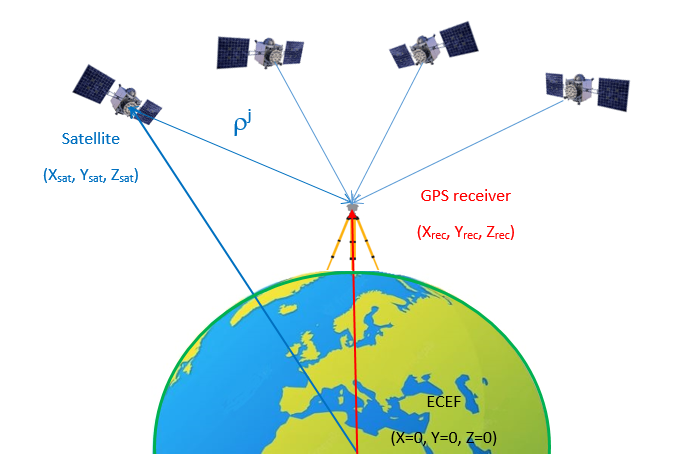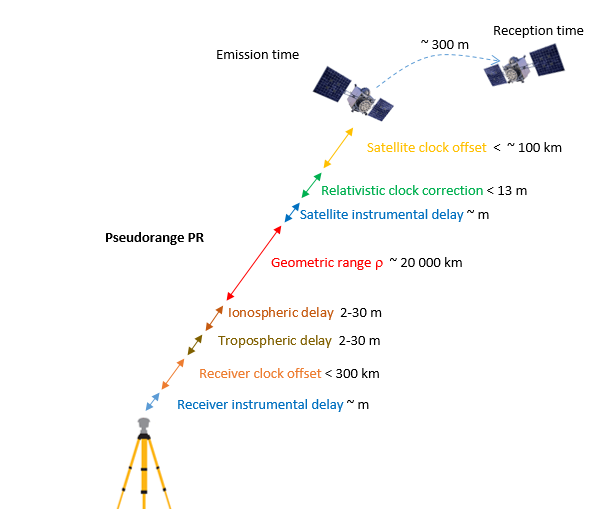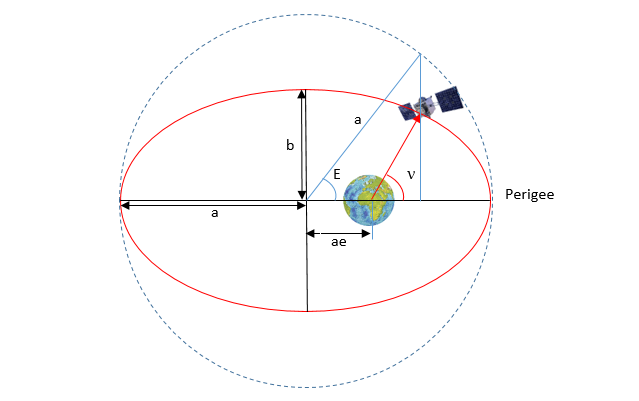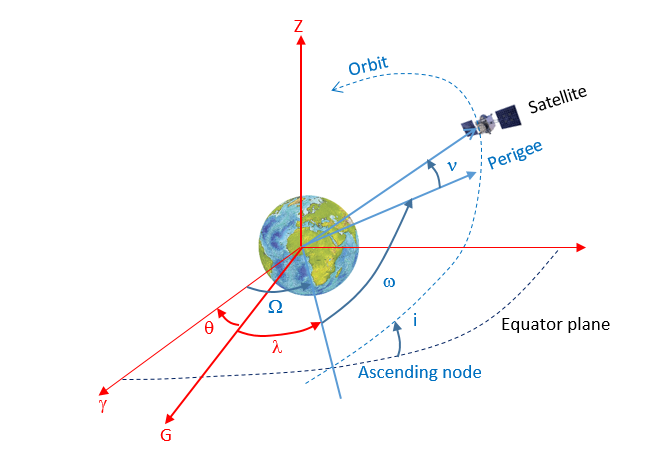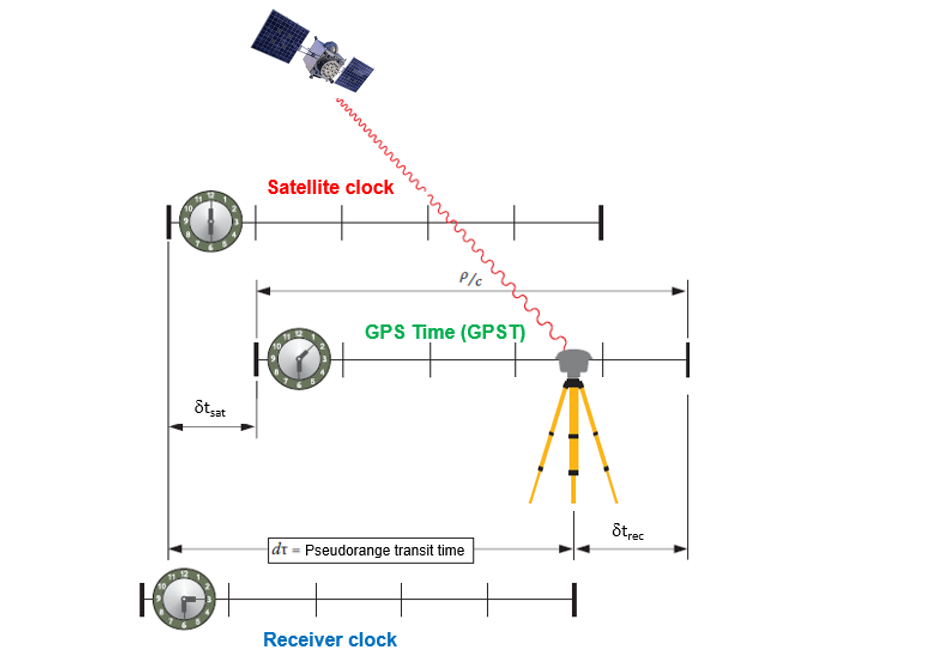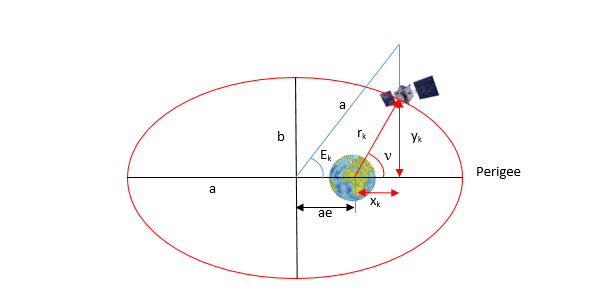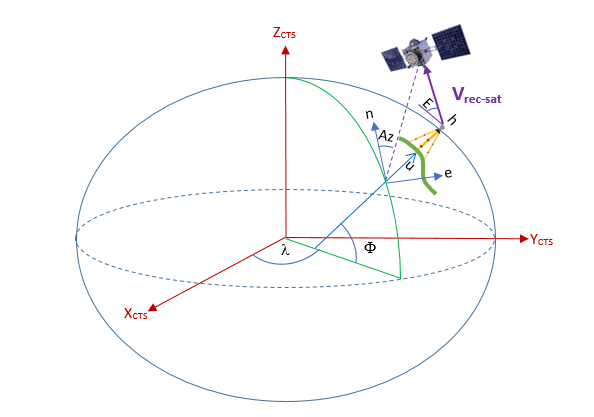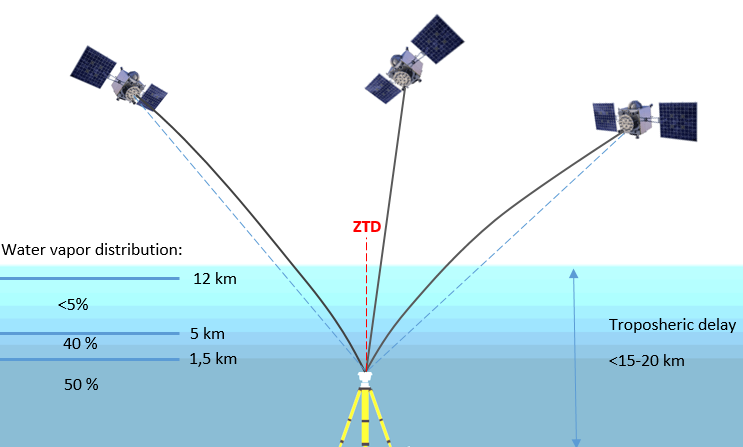XYZapprox = [1962040.2281, 844038.2429, 5989768.7110] # APPROX POSITION XYZ from Rinex
# prn, time og measurement, C1C, C2W/C2L
satobs1 = [['G01', 2022, 6, 15, 13, 59, 50, 22009709.740, 22009701.580],
['G08', 2022, 6, 15, 13, 59, 50, 21982005.060, 21981997.620],
['G10', 2022, 6, 15, 13, 59, 50, 21597421.060, 21597412.480],
['G14', 2022, 6, 15, 13, 59, 50, 22853592.900, 22853583.060],
['G21', 2022, 6, 15, 13, 59, 50, 21228529.140, 21228516.720],
['G22', 2022, 6, 15, 13, 59, 50, 24111518.280, 24111510.480],
['G24', 2022, 6, 15, 13, 59, 50, 23071483.120, 23071476.140],
['G27', 2022, 6, 15, 13, 59, 50, 24314409.040, 24314403.480]]
satobs = [['G01',2022,6,15,14,0,30,21985760.860,21985752.700],
['G08',2022,6,15,14,0,30,22000879.460,22000872.020],
['G10',2022,6,15,14,0,30,21611138.380,21611129.860],
['G14',2022,6,15,14,0,30,22855354.620,22855344.820],
['G21',2022,6,15,14,0,30,21222574.420,21222561.980],
['G22',2022,6,15,14,0,30,24085793.080,24085785.080],
['G24',2022,6,15,14,0,30,23063882.340,23063875.380],
['G27',2022,6,15,14,0,30,24344764.260,24344756.740]]
ephs1 = [['G01', 2022, 6, 15, 14, 0, 0, .340794678777E-03, -.784439180279E-11, .000000000000E+00,
.520000000000E+02, -.842500000000E+02, .416731644260E-08, .264235247830E-01,
-.429712235928E-05, .120090576820E-01, .735744833946E-06, .515366528702E+04,
.309600000000E+06, -.279396772385E-07, .224388442451E+01, .875443220139E-07,
.987856820887E+00, .374968750000E+03, .921269443462E+00, -.838463496799E-08,
-.380730144653E-09, .000000000000E+00, .221400000000E+04, .000000000000E+00,
.000000000000E+00, .000000000000E+00, .512227416039E-08, .520000000000E+02,
.309335000000E+06, .000000000000E+00, .000000000000E+00, .000000000000E+00],
['G08', 2022, 6, 15, 14, 0, 0, -.722706317902E-04, -.159161572810E-11, .000000000000E+00,
.820000000000E+02, .140875000000E+03, .459733435457E-08, .219640037703E+01,
.740587711334E-05, .744616868906E-02, .344030559063E-05, .515378232765E+04,
.309600000000E+06, -.184401869774E-06, .116075602777E+01, .195577740669E-06,
.963246002285E+00, .315625000000E+03, .173596929569E+00, -.824212903204E-08,
.228938107620E-09, .000000000000E+00, .221400000000E+04, .000000000000E+00,
.000000000000E+00, .000000000000E+00, .512227416039E-08, .820000000000E+02,
.309335000000E+06, .000000000000E+00, .000000000000E+00, .000000000000E+00],
['G10', 2022, 6, 15, 14, 0, 0, -.455882865936E-03, -.147792889038E-10, .000000000000E+00,
.580000000000E+02, -.136031250000E+03, .365872382910E-08, -.198612952341E+01,
-.702962279320E-05, .765492708888E-02, .103227794170E-04, .515368768883E+04,
.309600000000E+06, -.279396772385E-07, -.300850082132E+01, -.137835741043E-06,
.974342578239E+00, .189125000000E+03, -.249896124194E+01, -.737780731529E-08,
.143934566881E-09, .000000000000E+00, .221400000000E+04, .000000000000E+00,
.000000000000E+00, .000000000000E+00, .232830643654E-08, .580000000000E+02,
.309336000000E+06, .000000000000E+00, .000000000000E+00, .000000000000E+00],
['G14', 2022, 6, 15, 14, 0, 0, -.111524946988E-03, -.682121026330E-12, .000000000000E+00,
.150000000000E+02, .985625000000E+02, .447661504041E-08, -.130199759818E+01,
.498257577419E-05, .199141632766E-02, .110100954771E-04, .515366280174E+04,
.309600000000E+06, .707805156708E-07, .173366849128E+00, -.931322574615E-08,
.952816756894E+00, .163218750000E+03, -.313134934801E+01, -.778175271266E-08,
-.286440502825E-09, .000000000000E+00, .221400000000E+04, .000000000000E+00,
.000000000000E+00, .000000000000E+00, -.791624188423E-08, .783000000000E+03,
.309337000000E+06, .000000000000E+00, .000000000000E+00, .000000000000E+00],
['G21', 2022, 6, 15, 14, 0, 0, .161311123520E-03, .000000000000E+00, .000000000000E+00,
.480000000000E+02, -.690000000000E+02, .473019703169E-08, .235557719582E+01,
-.333972275257E-05, .242386998143E-01, -.119768083096E-05, .515374702072E+04,
.309600000000E+06, .441446900368E-06, .214969297667E+01, .117346644402E-06,
.960199874762E+00, .397781250000E+03, -.937445853228E+00, -.824212903204E-08,
-.492163357722E-09, .000000000000E+00, .221400000000E+04, .000000000000E+00,
.000000000000E+00, .000000000000E+00, -.102445483208E-07, .480000000000E+02,
.309338000000E+06, .000000000000E+00, .000000000000E+00, .000000000000E+00],
['G22', 2022, 6, 15, 14, 0, 0, .276219565421E-03, .636646291241E-11, .000000000000E+00,
.790000000000E+02, .637500000000E+01, .447268630534E-08, .209109460950E+01,
.281259417534E-06, .134111947846E-01, .758469104767E-05, .515369627380E+04,
.309600000000E+06, .134110450745E-06, -.187625357347E+01, -.329688191414E-06,
.961125351849E+00, .230781250000E+03, -.184820560104E+01, -.769603485646E-08,
.706100840506E-09, .000000000000E+00, .221400000000E+04, .000000000000E+00,
.000000000000E+00, .000000000000E+00, -.838190317154E-08, .790000000000E+02,
.309485000000E+06, .000000000000E+00, .000000000000E+00, .000000000000E+00],
['G24', 2022, 6, 15, 14, 0, 0, .220152083784E-03, -.841282599140E-11, .000000000000E+00,
.840000000000E+02, -.106875000000E+02, .558523264736E-08, .346157288052E+00,
-.622123479843E-06, .125489170896E-01, .565126538277E-05, .515367090797E+04,
.309600000000E+06, -.782310962677E-07, -.991197407488E+00, .219792127609E-06,
.933901572841E+00, .259656250000E+03, .817978952381E+00, -.853106963901E-08,
-.304655547269E-09, .000000000000E+00, .221400000000E+04, .000000000000E+00,
.000000000000E+00, .000000000000E+00, .279396772385E-08, .840000000000E+02,
.309339000000E+06, .000000000000E+00, .000000000000E+00, .000000000000E+00],
['G27', 2022, 6, 15, 14, 0, 0, .215651467443E-03, .329691829393E-11, .000000000000E+00,
.700000000000E+02, .148187500000E+03, .440161191623E-08, .225401738364E+01,
.754743814468E-05, .105409963289E-01, .368244946003E-05, .515365896797E+04,
.309600000000E+06, -.240281224251E-06, .118118244570E+01, -.150874257088E-06,
.971982136512E+00, .313812500000E+03, .688193783108E+00, -.803997775449E-08,
.273225666660E-09, .000000000000E+00, .221400000000E+04, .000000000000E+00,
.100000000000E+01, .000000000000E+00, .186264514923E-08, .700000000000E+02,
.309340000000E+06, .000000000000E+00, .000000000000E+00, .000000000000E+00]]
ephs =[['G01', 2022,6,15,16,0,0,.340738333762E-03,-.784439180279E-11,.000000000000E+00,
.540000000000E+02,-.773437500000E+02,.429303596504E-08,.107670373452E+01,
-.395812094212E-05,.120082932990E-01,.612810254097E-06,.515366287804E+04,
.316800000000E+06,-.912696123123E-07,.224382395479E+01,.147148966789E-06,
.987854126192E+00,.385250000000E+03,.921173225877E+00,-.836713423901E-08,
-.345014371233E-09,.000000000000E+00,.221400000000E+04,.000000000000E+00,
.000000000000E+00,.000000000000E+00,.512227416039E-08,.540000000000E+02,
.309628000000E+06,.000000000000E+00,.000000000000E+00,.000000000000E+00],
['G08',2022,6,15,16,0,0,-.722822733223E-04,-.159161572810E-11,.000000000000E+00,
.830000000000E+02,.150718750000E+03,.456054710795E-08,-.303652790620E+01,
.783987343311E-05,.744804507121E-02,.411830842495E-05,.515377832794E+04,
.316800000000E+06,-.152736902237E-06,.116069700634E+01,-.447034835815E-07,
.963248680888E+00,.303375000000E+03,.173456537710E+00,-.807605068564E-08,
.300012496725E-09,.000000000000E+00,.221400000000E+04,.000000000000E+00,
.000000000000E+00,.000000000000E+00,.512227416039E-08,.830000000000E+02,
.309618000000E+06,.000000000000E+00,.000000000000E+00,.000000000000E+00],
['G10',2022,6,15,16,0,0,-.455989036709E-03,-.147792889038E-10,.000000000000E+00,
.840000000000E+02,-.154406250000E+03,.376515683390E-08,-.935626010933E+00,
-.817887485027E-05,.765509542543E-02,.104885548353E-04,.515369258881E+04,
.316800000000E+06,.203028321266E-06,-.300855339128E+01,.912696123123E-07,
.974342123272E+00,.186187500000E+03,-.249930062284E+01,-.761103131572E-08,
-.496449250533E-10,.000000000000E+00,.221400000000E+04,.000000000000E+00,
.100000000000E+01,.000000000000E+00,.232830643654E-08,.840000000000E+02,
.309619000000E+06,.000000000000E+00,.000000000000E+00,.000000000000E+00],
['G14',2022,6,15,16,0,0,-.111529603601E-03,-.682121026330E-12,.000000000000E+00,
.160000000000E+02,.826562500000E+02,.437018203562E-08,-.251014454845E+00,
.437907874584E-05,.199296663050E-02,.110045075417E-04,.515366699409E+04,
.316800000000E+06,.391155481339E-07,.173310839846E+00,.372529029846E-07,
.952814682476E+00,.163093750000E+03,-.313214701434E+01,-.779961059937E-08,
-.283226083217E-09,.000000000000E+00,.221400000000E+04,.000000000000E+00,
.000000000000E+00,.000000000000E+00,-.791624188423E-08,.784000000000E+03,
.309620000000E+06,.000000000000E+00,.000000000000E+00,.000000000000E+00],
['G21',2022,6,15,16,0,0,.161311123520E-03,.000000000000E+00,.000000000000E+00,
.520000000000E+02,-.630625000000E+02,.467519474063E-08,-.287745316399E+01,
-.290945172310E-05,.242399923736E-01,-.149756669998E-05,.515374453163E+04,
.316800000000E+06,.204890966415E-07,.214963212220E+01,.389292836189E-06,
.960198189480E+00,.405531250000E+03,-.937461246052E+00,-.809105131048E-08,
-.133219834855E-09,.000000000000E+00,.221400000000E+04,.000000000000E+00,
.000000000000E+00,.000000000000E+00,-.102445483208E-07,.520000000000E+02,
.309621000000E+06,.000000000000E+00,.000000000000E+00,.000000000000E+00],
['G22',2022,6,15,16,0,0,.276264734566E-03,.636646291241E-11,.000000000000E+00,
.820000000000E+02,.171875000000E+01,.443554190098E-08,.314129354829E+01,
.184401869774E-06,.134117096895E-01,.768713653088E-05,.515369504356E+04,
.316800000000E+06,.145286321640E-06,-.187630757124E+01,-.875443220139E-07,
.961130650538E+00,.228937500000E+03,-.184823787448E+01,-.753888545341E-08,
.637526555540E-09,.000000000000E+00,.221400000000E+04,.000000000000E+00,
.000000000000E+00,.000000000000E+00,-.838190317154E-08,.820000000000E+02,
.309622000000E+06,.000000000000E+00,.000000000000E+00,.000000000000E+00],
['G24',2022,6,15,16,0,0,.220091082156E-03,-.841282599140E-11,.000000000000E+00,
.850000000000E+02,-.113750000000E+02,.552022993973E-08,.139631594392E+01,
-.678002834320E-06,.125492629595E-01,.570528209209E-05,.515367191124E+04,
.316800000000E+06,-.189989805222E-06,-.991258418486E+00,.838190317154E-07,
.933898960069E+00,.256125000000E+03,.818009805323E+00,-.849606818106E-08,
-.373229832235E-09,.000000000000E+00,.221400000000E+04,.000000000000E+00,
.000000000000E+00,.000000000000E+00,.279396772385E-08,.850000000000E+02,
.309623000000E+06,.000000000000E+00,.000000000000E+00,.000000000000E+00],
['G27',2022,6,15,16,0,0,.215674750507E-03,.329691829393E-11,.000000000000E+00,
.710000000000E+02,.162375000000E+03,.431732269096E-08,-.297898170629E+01,
.817701220512E-05,.105392733822E-01,.352598726749E-05,.515366197205E+04,
.316800000000E+06,-.726431608200E-07,.118112470578E+01,-.257045030594E-06,
.971984339666E+00,.317718750000E+03,.688196155961E+00,-.801533387083E-08,
.314655963827E-09,.000000000000E+00,.221400000000E+04,.000000000000E+00,
.100000000000E+01,.000000000000E+00,.186264514923E-08,.710000000000E+02,
.309624000000E+06,.000000000000E+00,.000000000000E+00,.000000000000E+00]]
